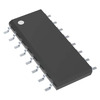Manufacturer Part Number
TLC1078CD
Manufacturer
Texas Instruments
Introduction
The TLC1078CD is a dual operational amplifier (op-amp) integrated circuit (IC) designed for general-purpose instrumentation and buffer applications.
Product Features and Performance
Dual op-amp configuration with two independent amplifiers in a single package
High input impedance and low input bias current
Wide supply voltage range from 1.4V to 16V
High gain-bandwidth product of 110kHz
Low offset voltage of 180μV
High slew rate of 0.032V/μs
Quiescent current of 29μA per channel
Product Advantages
Versatile and flexible due to the dual op-amp design
Suitable for a wide range of applications with the wide supply voltage range
Excellent performance characteristics for instrumentation and buffering applications
Low power consumption making it suitable for battery-powered devices
Key Technical Parameters
Package: 8-SOIC (0.154", 3.90mm Width)
Mounting Type: Surface Mount
Operating Temperature: 0°C to 70°C
RoHS Compliance: RoHS3 Compliant
Quality and Safety Features
Manufactured using Texas Instruments' LinCMOS technology for reliable operation
Tested and qualified to meet strict quality and reliability standards
Compatibility
Suitable for a wide range of instrumentation, buffer, and general-purpose amplifier applications
Application Areas
Instrumentation and measurement equipment
Signal conditioning and buffering
Portable and battery-powered devices
General-purpose amplifier circuits
Product Lifecycle
The TLC1078CD is an active and currently available product from Texas Instruments.
Replacement or upgrade options may be available from Texas Instruments' portfolio of op-amp ICs.
Key Reasons to Choose the TLC1078CD
Dual op-amp design provides flexibility and versatility
Wide supply voltage range allows use in various applications
Excellent performance characteristics, including high gain-bandwidth, low offset voltage, and high slew rate
Low power consumption makes it suitable for battery-powered devices
Reliable and quality-assured manufacturing using Texas Instruments' LinCMOS technology





 TLC1079Texas Instruments
TLC1079Texas Instruments TLC085AIDRTexas InstrumentsIC OPAMP GP 4 CIRCUIT 16SOIC
TLC085AIDRTexas InstrumentsIC OPAMP GP 4 CIRCUIT 16SOIC